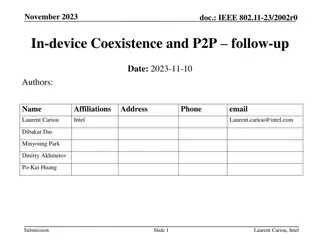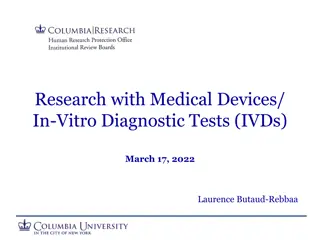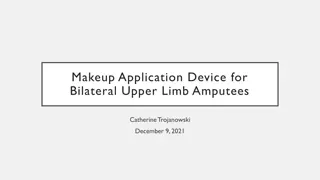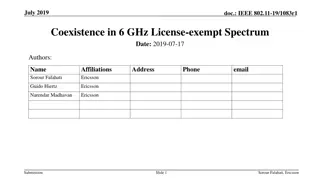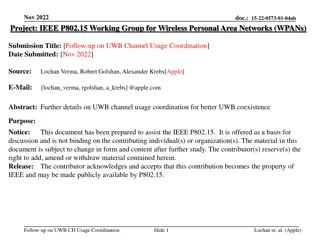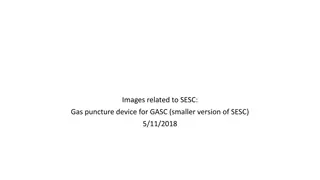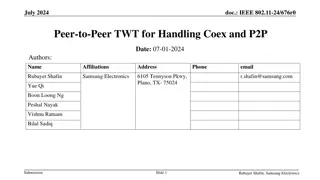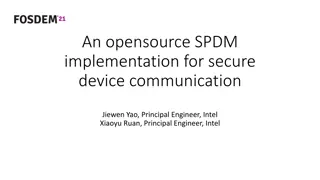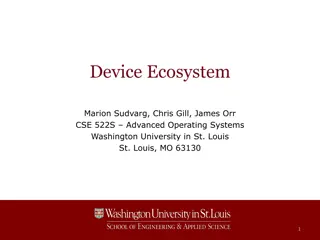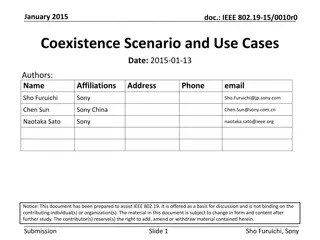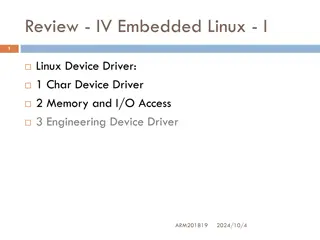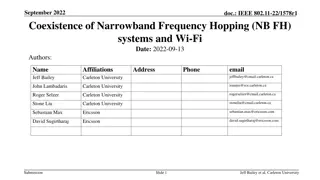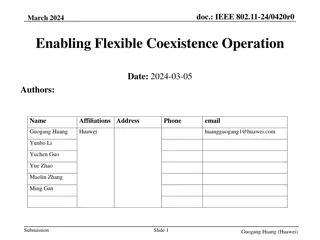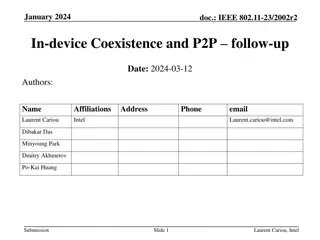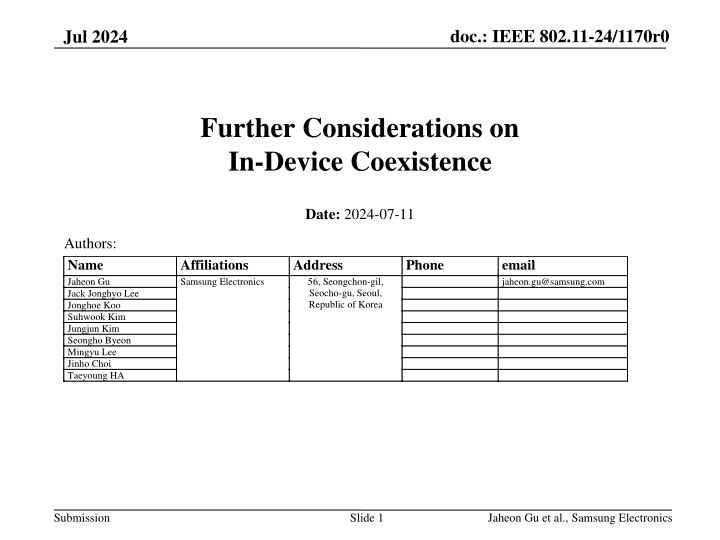
Optimizing In-Device Coexistence for Enhanced Performance
Explore the latest insights on In-Device Coexistence (IDC) in mobile devices, addressing challenges and proposing solutions to ensure seamless operation of multiple radio access technologies. Learn about strategies to inform access points about IDC activities for improved performance and reduced interference.
Download Presentation

Please find below an Image/Link to download the presentation.
The content on the website is provided AS IS for your information and personal use only. It may not be sold, licensed, or shared on other websites without obtaining consent from the author. If you encounter any issues during the download, it is possible that the publisher has removed the file from their server.
You are allowed to download the files provided on this website for personal or commercial use, subject to the condition that they are used lawfully. All files are the property of their respective owners.
The content on the website is provided AS IS for your information and personal use only. It may not be sold, licensed, or shared on other websites without obtaining consent from the author.
E N D
Presentation Transcript
January 2024 doc.: IEEE 802.11-24/1170r0 Jul 2024 Further Considerations on In-Device Coexistence Date: 2024-07-11 Authors: Name Jaheon Gu Jack Jonghyo Lee Jonghoe Koo Suhwook Kim Jungjun Kim Seongho Byeon Mingyu Lee Jinho Choi Taeyoung HA Affiliations Samsung Electronics Address 56, Seongchon-gil, Seocho-gu, Seoul, Republic of Korea Phone email jaheon.gu@samsung.com Submission Slide 1 Jaheon Gu et al., Samsung Electronics
doc.: IEEE 802.11-24/1170r0 Jul 2024 Introduction The accommodation of other radio access technologies together has discussed under the term In-Device Coexistence (IDC) [1]- [4] At certain times or frequencies, it may not be possible for different radio access technologies to operate simultaneously 2.4 GHz band: Bluetooth / BLE / P2P 5 & 6 GHz bands: P2P, UWB, 3GPP radio (such as LAA / NR-U) In a STA that simultaneously utilizes multiple radio access technologies, it is inevitable to experience performance degradation caused by coexisting IDC activities (e.g. a sudden drop of data rates, increased latency, buffer overflow, etc.) One effective approach would be to inform AP about IDC activities and define appropriate actions based on this information. Submission Slide 2 Jaheon Gu et al., Samsung Electronics
doc.: IEEE 802.11-24/1170r0 Jul 2024 Backgrounds From our perspective, it is valuable to discuss periodic, deterministic, and long-term IDC as the majority of use cases in mobile devices follow this pattern By supporting IDC, we enable the execution of one or more unavailable durations within a specified periodic or instantaneous timeframe Existing protocols [5] can be considered as potential options for IDC, requiring modification and extension to meet specific requirements of IDC The TWT element can include subfields specifying the duration of an IDC activity and the interval between two consecutive IDC activities. The Channel Usage element can contain relevant channel information related to the operating channel of IDC There are other elements like QTP, QPR that can potentially become part of the protocol supporting IDC functionalities Submission Slide 3 Jaheon Gu et al., Samsung Electronics
doc.: IEEE 802.11-24/1170r0 Jul 2024 Further Considerations on IDC Each IDC activity may have a periodicity requirement to ensure its stable and reliable operations The requirement can be defined by specifying parameters such as the unique start time, duration, interval, and expected number of repetitions In the scenario where multiple IDC activities are taking place within a STA, the availability of Wi-Fi should be assessed while considering all these concurrent IDC activities An AP should avoid any downlink transmission or uplink scheduling for a STA when the STA is in its unavailable periods Interval of IDC1 Wi-Fi Wi-Fi Wi-Fi Wi-Fi IDC1 IDC1 IDC1 IDC1 IDC2 IDC2 Period of IDC1 Period of IDC2 Interval of IDC2 Submission Slide 4 Jaheon Gu et al., Samsung Electronics
doc.: IEEE 802.11-24/1170r0 Jul 2024 Further Considerations on IDC To offer practical support for IDC of STAs, we are considering methods: To indicate the following actions related to IDC activities: Adding a new IDC activity or removing an existing one Suspending, resuming, or reconfiguring an already added (or registered) IDC activity Add IDC1 (Cycle: T1/P1) Reconfigure IDC1 (Cycle: T1/P1 T11/P11) Add IDC2 (Cycle: T2/P2) Suspend / Remove IDC1 Wi-Fi IDC1 IDC2 To inform the specific radio mode of IDC activities (such as Tx-/Rx-only IDC) and Wi-Fi capabilities (like the number of spatial streams (NSS) and the operating bandwidth) while engaging in IDC activities. 1x1 Rx Available 2x2 Rx Available IDC1 Rx 2x2 Rx Available IDC1 Rx IDC2 Rx Submission Slide 5 Jaheon Gu et al., Samsung Electronics
doc.: IEEE 802.11-24/1170r0 Jul 2024 Further Considerations on IDC To offer practical support for IDC of STAs, we are considering methods: To specify the number of repetition counts associated with IDC activity For example, some applications require running a predefined number of periods for IDC Add IDC1 (3 repetitions) Remove IDC1 (without extra signals) Wi-Fi IDC1 To Announce the type and profile of IDC activity Type: P2P, Bluetooth, BLE, Profile: Peer information for P2P, Role-specific information for STA s IDC (e.g. Owner / Client), This Information can be used for prioritization, further enhancement, and coordination from the AP side Submission Slide 6 Jaheon Gu et al., Samsung Electronics
January 2024 doc.: IEEE 802.11-24/1170r0 Jul 2024 Summary From mobile device s standpoint, discussions regarding IDC support have focused on addressing several key considerations: Indicating the addition, removal, suspension, resumption, and reconfiguration of IDC activities Defining the transmit or receive mode of the IDC operations Notifying reduction in Wi-Fi capabilities while operating IDC Specifying the number of repetitions for IDC activity Announcing the type and profile of IDC activity Potential solutions for practical standardization should be further discussed: Reusing existing elements Introducing a new element dedicated to IDC support Submission Slide 7 Jaheon Gu et al., Samsung Electronics
January 2024 doc.: IEEE 802.11-24/1170r0 Jul 2024 References [1] 11-23/2002r2 In-device Coexistence and P2P follow-up (Laurent Cariou, Intel) [2] 11-23/1964r1 In-Device Coexistence (Alfred Asterjadhi, Qaulcomm) [3] 11-24/0420r2 Enabling Flexible Coexistence Operation (Guogang Huang, Huawei) [4] 11-24/0436r0 SP Based In-Device Coexistence (Yuchen Guo, Huawei) [5] IEEE P802.11-REVme/D6.0, June 2024 Submission Slide 8 Jaheon Gu et al., Samsung Electronics
doc.: IEEE 802.11-24/1170r0 Jul 2024 Straw Poll 1 Do you agree to define a mechanism for a STA to announce addition, deletion, suspension, resumption, and reconfiguration of its periodic unavailability? Which frame to use is TBD Optional / Mandatory is TBD Submission Slide 9 Jaheon Gu et al., Samsung Electronics
doc.: IEEE 802.11-24/1170r0 Jul 2024 Straw Poll 2 Do you agree to define a radio mode of IDC activities and Wi-Fi capabilities while engaging in the IDC periods? Mode of IDC activities: Tx-only IDC, Rx-only IDC, Both Tx & Rx IDC Wi-Fi Capabilities: the number of spatial streams (NSS), the operating bandwidth, and further capabilities TBD Submission Slide 10 Jaheon Gu et al., Samsung Electronics


